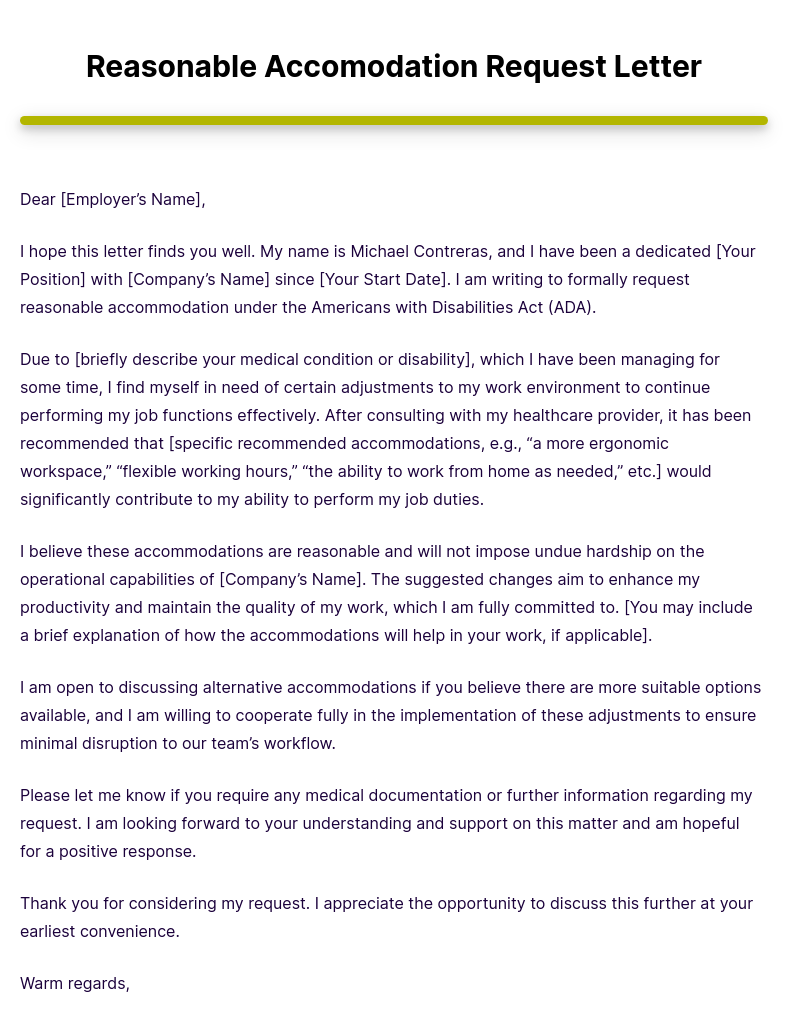Utilizing a standardized form benefits both employees and employers. It empowers individuals to confidently and effectively communicate their needs, fostering a more inclusive work environment. Simultaneously, it provides employers with a consistent framework for managing accommodation requests, promoting legal compliance and equitable treatment across the workforce. Clear communication through such a form helps prevent misunderstandings and ensures that all parties are working with the same relevant information.

Further exploration of this topic will cover best practices for completing such forms, legal considerations for employers, examples of common accommodations, and strategies for fostering open communication between employees and employers during the accommodation process.
Key Components of a Standardized Accommodation Request Form
Effective accommodation requests require specific information to ensure clarity and facilitate a smooth interactive process. The following components are crucial for a comprehensive and well-structured request.
1: Employee Information: Full name, job title, department, and contact information are essential for identification and follow-up communication.
2: Nature of Disability or Religious Belief: A concise description of the disability or religious belief necessitating the accommodation is crucial, though detailed medical documentation is generally not required at this stage.
3: Specific Limitations: A clear explanation of how the disability or religious belief impacts job performance or creates barriers in the work environment should be provided.
4: Requested Accommodation: The specific modification or adjustment being requested should be clearly articulated. Providing multiple options, if applicable, can facilitate the interactive process.
5: Justification for Accommodation: A brief explanation of how the requested accommodation will effectively address the limitations and enable successful job performance is helpful.
6: Supporting Documentation (Optional): While not always mandatory at the initial request stage, supporting documentation from medical professionals or religious leaders can be valuable for substantiating the need for accommodation.
7: Date and Signature: Including the date and employee’s signature formalizes the request and initiates the interactive process.
A well-crafted request facilitates open communication and successful implementation of accommodations, creating a more inclusive and productive work environment.
How to Create a Reasonable Accommodation Request Template
Creating a standardized template ensures consistency and clarity in handling accommodation requests. A well-designed template facilitates a smoother interactive process between employees and employers.
1: Header: The template should begin with a clear header, such as “Reasonable Accommodation Request Form.” Include space for the date of the request.
2: Employee Information Section: Fields for employee’s full name, job title, department, contact information, and employee ID should be included.
3: Nature of Request Section: This section allows employees to specify whether the request is related to a disability or religious belief. Clear and concise language should be used.
4: Description of Limitation Section: This section provides space for employees to describe how their disability or religious belief impacts their job performance or creates barriers in the work environment. Focusing on functional limitations rather than diagnoses is recommended.
5: Requested Accommodation Section: This section should clearly outline the specific modification or adjustment being requested. Including space for alternative accommodations is beneficial.
6: Justification Section: This section allows employees to explain how the requested accommodation will address the limitations and facilitate successful job performance.
7: Supporting Documentation Section: While not always required at the initial request stage, a designated space for optional supporting documentation should be included.
8: Signature and Date Section: Include lines for the employee’s signature and date, formalizing the request.
A comprehensive and user-friendly template empowers employees to clearly articulate their needs while providing employers with the necessary information to effectively assess and implement accommodations. This structured approach promotes a more inclusive and equitable work environment.
Standardized forms for accommodation requests provide a crucial framework for fostering inclusivity and ensuring equitable treatment within the workplace. These templates streamline the process, enabling clear communication between employees and employers regarding necessary adjustments related to disabilities or religious beliefs. Key components such as detailed descriptions of limitations and proposed accommodations, coupled with optional supporting documentation, empower both parties to engage in a productive interactive process. Well-designed templates promote legal compliance, facilitate effective implementation of reasonable accommodations, and contribute to a more positive and productive work environment.
Effective implementation of accommodation request procedures signifies a commitment to diversity, equity, and inclusion. Proactive measures to create and utilize standardized templates contribute to a more accessible and equitable workplace for all. Continued focus on these practices is essential for building a truly inclusive workforce where every individual can thrive.